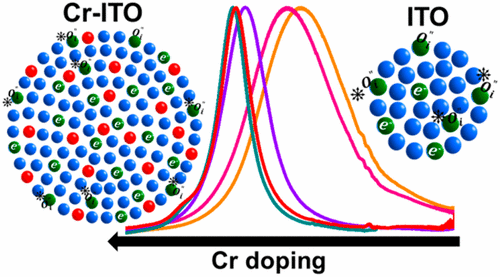当前位置:
X-MOL 学术
›
Chem. Mater.
›
论文详情
Our official English website, www.x-mol.net, welcomes your feedback! (Note: you will need to create a separate account there.)
Size-Induced Enhancement of Carrier Density, LSPR Quality Factor, and Carrier Mobility in Cr–Sn Doped In2O3 Nanocrystals
Chemistry of Materials ( IF 8.6 ) Pub Date : 2017-10-31 00:00:00 , DOI: 10.1021/acs.chemmater.7b03351 Bharat Tandon 1 , Anur Yadav 1 , Deepak Khurana 2 , Pranavi Reddy 1 , Pralay K. Santra 3 , Angshuman Nag 1, 4
Chemistry of Materials ( IF 8.6 ) Pub Date : 2017-10-31 00:00:00 , DOI: 10.1021/acs.chemmater.7b03351 Bharat Tandon 1 , Anur Yadav 1 , Deepak Khurana 2 , Pranavi Reddy 1 , Pralay K. Santra 3 , Angshuman Nag 1, 4
Affiliation

|
Heterovalent dopant ions, such as Sn4+, in In2O3 nanocrystals (NCs) provide free electrons for localized surface plasmon resonance (LSPR). But the same heterovalent dopants act as electron scattering centers, both independently and by forming complexes with interstitial oxygen, thereby increasing LSPR line width. Also, such complexes decrease free carrier density. These detrimental effects diminish the figure-of-merit of LSPR known as the quality factor (Q-factor). Herein, we designed colloidal Cr–Sn codoped In2O3 NCs, where both high carrier density and low carrier scattering can be achieved simultaneously, yielding a high LSPR Q-factor of 7.2, which is a record high number compared to prior reports of doped In2O3 NCs. Q-factors increase systematically from 3.2 for 6.6% Sn doped In2O3 NCs to 7.2 for 23.8% Cr–6.6% Sn codoped In2O3 NCs by increasing the Cr codoping concentration, which is also accompanied by an increase in NC size from 6.7 to 22.1 nm. Detailed characterization and analysis of LSPR spectra using Drude model suggest that the increase in NC size (induced by Cr codoping) is mainly responsible for the enhanced LSPR Q-factor. Sn4+ dopants on the surface of NCs are more vulnerable to form irreducible complexes with interstitial oxide ions, compared to Sn4+ ions in the core. Therefore, an increase in the concentration ratio of [Sncore]/[Snsurface] (or [Sn]/[interstitial oxide]) by increasing the size of NCs, increases the carrier density. Furthermore, such increase in both NC size and Cr doping influences multiple factors reducing the scattering of charge carriers, thereby increasing the optical carrier mobility. This unique combination, which increases both the density and mobility of charge carriers, improves the LSPR Q-factor.
中文翻译:

尺寸诱导的2 O 3纳米晶掺杂Cr-Sn的载流子密度,LSPR质量因子和载流子迁移率的增强
In 2 O 3纳米晶体(NCs)中的异质掺杂离子(例如Sn 4+)提供自由电子,用于局部表面等离子体激元共振(LSPR)。但是,相同的异质掺杂剂既可以独立地发挥作用,也可以通过与间隙氧形成络合物而充当电子散射中心,从而增加LSPR线宽。同样,这种复合物降低了自由载流子密度。这些有害影响会降低LSPR的品质因数(品质因数(Q因数))。在这里,我们设计了共掺杂In 2 O 3的Cr-Sn胶体可以同时实现高载流子密度和低载流子散射的NC,产生的LSPR Q因子很高,为7.2,与以前掺杂In 2 O 3 NC的报道相比,这是创纪录的数字。Q因子系统地增加从3.2 6.6%的Sn掺杂的In 2吨ö 3的NC至7.2 23.8%的Cr-6.6%Sn的共掺杂在2吨ö 3的NC通过增加Cr的共掺杂浓度,这也伴随着增加NC尺寸从6.7到22.1nm 使用Drude模型对LSPR光谱进行详细的表征和分析表明,NC尺寸的增加(由Cr共掺杂引起)主要是LSPR Q因子增强的原因。锡4+与核心中的Sn 4+离子相比,NCs表面的掺杂剂更容易与间隙氧化物离子形成不可还原的络合物。因此,通过增加NC的尺寸来增加[Sn核] / [Sn表面](或[Sn] / [间隙氧化物])的浓度比,会增加载流子密度。此外,这种NC尺寸和Cr掺杂的增加影响减少电荷载流子散射的多种因素,从而增加了光学载流子迁移率。这种独特的组合提高了电荷载流子的密度和迁移率,改善了LSPR Q因子。
更新日期:2017-11-01
中文翻译:

尺寸诱导的2 O 3纳米晶掺杂Cr-Sn的载流子密度,LSPR质量因子和载流子迁移率的增强
In 2 O 3纳米晶体(NCs)中的异质掺杂离子(例如Sn 4+)提供自由电子,用于局部表面等离子体激元共振(LSPR)。但是,相同的异质掺杂剂既可以独立地发挥作用,也可以通过与间隙氧形成络合物而充当电子散射中心,从而增加LSPR线宽。同样,这种复合物降低了自由载流子密度。这些有害影响会降低LSPR的品质因数(品质因数(Q因数))。在这里,我们设计了共掺杂In 2 O 3的Cr-Sn胶体可以同时实现高载流子密度和低载流子散射的NC,产生的LSPR Q因子很高,为7.2,与以前掺杂In 2 O 3 NC的报道相比,这是创纪录的数字。Q因子系统地增加从3.2 6.6%的Sn掺杂的In 2吨ö 3的NC至7.2 23.8%的Cr-6.6%Sn的共掺杂在2吨ö 3的NC通过增加Cr的共掺杂浓度,这也伴随着增加NC尺寸从6.7到22.1nm 使用Drude模型对LSPR光谱进行详细的表征和分析表明,NC尺寸的增加(由Cr共掺杂引起)主要是LSPR Q因子增强的原因。锡4+与核心中的Sn 4+离子相比,NCs表面的掺杂剂更容易与间隙氧化物离子形成不可还原的络合物。因此,通过增加NC的尺寸来增加[Sn核] / [Sn表面](或[Sn] / [间隙氧化物])的浓度比,会增加载流子密度。此外,这种NC尺寸和Cr掺杂的增加影响减少电荷载流子散射的多种因素,从而增加了光学载流子迁移率。这种独特的组合提高了电荷载流子的密度和迁移率,改善了LSPR Q因子。



























 京公网安备 11010802027423号
京公网安备 11010802027423号